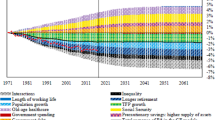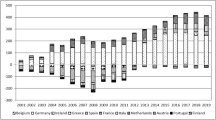Abstract
This paper uses a stylized budgeting and growth framework to analyze the effects of various shocks on public finances and growth. The framework is applied to the case of Ireland, where recently these shocks have played an important role. Ireland was strongly affected by the global financial crisis and the collapse of a housing price bubble caused a deep recession and budgetary instability. We focus on the impacts of primary fiscal balance shocks, growth and interest rate shocks on budgetary sustainability and growth. A scenario analysis of budgetary adjustment in the short and medium run under alternative hypotheses is carried out to assess Irish fiscal sustainability and growth.









Similar content being viewed by others
Notes
Close to 90 % of Irish manufacturing exports is produced by foreign multinationals. See e.g. Ryan and Giblin (2012), Godart et al. (2012) and OECD (2013) e.g. for a more detailed analysis of Irish export performance and the role of FDI, R&D and education in fostering high tech exports, growth, productivity and innovation. In particular, FDI contributes to clustering of firms and external economies, such as a skilled labour pool and knowledge spillovers from having firms cluster around a particular activity in a region Further FDI is attracted to industrial clusters augmenting cluster development and dynamics. OECD (2008) provides a comprehensive review of Ireland’s R&D performance and strategy.
See Afonso (2005) for a more detailed analysis of budgetary sustainability in European countries. Note that the fiscal balance gap can be easily extended with additional fiscal sustainability gaps, calculated by replacing the current debt with a debt target, e.g. a 60 % debt-to-GDP ratio of the Maastricht Treaty.
The risk-premium implies that the dynamics of government debt become quadratic in the debt level, \( {b}_t=\left(1-g{r}_r^r+{r}_t+{\alpha}_1\right)\ {b}_{t-1}-{d}_t^p+sf{a}_t+{\beta}_1\left({d}_t+sf{a}_t+\frac{1}{AM}{b}_{t-1}\right){b}_{t-1} \) This non-linearity extends therefore the standard approach to analyze government debt dynamics that ignores a link between risk premia and the debt level, i.e. β 1 = 0. In that case the interest rate-growth differential is constant and the debt-dynamics are linear. The equation reduces to a standard linear difference equation in debt and debt dynamics are stable (unstable) in case growth exceeds (is lower than) the interest rate. β 1 measures the strength of the non-linearity in the debt dynamics: a higher value β 1 of makes the debt dynamics increasingly non-linear and unstable.
See e.g. Baldacci and Kumar (2010) for more details on the formation of risk premia in sovereign bond markets. Their empirical estimations of determinants of risk premia for a set of 31 countries uses a comparable approach as (12). Bernoth et al. (2004) and Arghyroua and Kontonikas (2011) provide a detailed a detailed analysis of risk premia in euro area sovereign debt markets.
Note that residential investment is statistically accounted in gross capital formation, its share being of the order of 50 % and more in many countries.
“Of this, a €35.6 billion transfer to Anglo Irish Bank, Irish Nationwide Building Society and the Educational Building Society led to an increase in the gross debt, while a €10.7 billion directed investment by the NPRF into Allied Irish Bank (€7.2 billion) and Bank of Ireland (€3.5 billion) led to a concomitant depletion of liquid assets and an increase in the net debt.”
References
Afonso A (2005) Fiscal sustainability: the unpleasant European case. Finanz Arch 61(1):19–44
Ahearne A, Delgado J, von Weiszaecker J (2008). A tail of two countries, Brueghel Policy brief 2008/04
Arghyroua M, Kontonikas A (2011) The EMU Sovereign-Debt Crisis: Fundamentals, Expectations and Contagion. DG-ECFIN Economic Papers no.436, February 2011, Brussels
Baldacci E, Kumar M (2010) Fiscal deficits, public debt, and sovereign bond yields, IMF Discussion Paper WP/10/184
Barry F, Devereux M (2006) A theoretical growth model for Ireland. Econ Soc Rev 37(2):245–262
Bernoth K, von Hagen J, Schuhknecht L (2004) Sovereign risk premiums in the European Government Bond Market. ECB Working Paper No.369
Drudy P, Collins M (2011) Ireland: from boom to austerity. Camb J Reg Econ Soc 4(3):339–354
FitzGerald J, Kearney I (2011) Irish Government debt and implied debt dynamics: 2011–2015, mimeo
Giavazzi F, Japelli T, Pagano M (1990) Searching for non-Keynesian effects of fiscal policy. Eur Econ Rev 44:1259–1290
Godart O, Goerg H, Hanley A (2012) Surviving the crisis: foreign multinationals versus domestic firms. World Econ 35(11):1305–1321
Honohan P, Walsh B (2002) Catching up with the leaders: the Irish Hare. Brook Pap Econ Act 33(1):1–78
Honohan P, Donovan D, Gorecki P, Mottiar R (2010) The Irish banking crisis regulatory and financial stability policy 2003–2008. A Report to the Minister for Finance by the Governor of the Central Bank. Central Bank of Ireland
Lane P (2011) The dynamics of Ireland’s net external position, mimeo
OECD (2008) OECD Science, Technology and Industry Outlook 2008
OECD (2013) OECD Economic Surveys Ireland
McHale J (2012) An overview of developments in the Irish Economy over the last ten years. World Econ 35(11):1220–1238
Ryan P, Giblin M (2012) High-Tech clusters, innovation capabilities and technological entrepreneurship: evidence from Ireland. World Econ 35(11):1322–1339
Acknowledgments
The authors wish to thank Frank Smets, Ron Davies, John McHale, Gerda Dewit, Christian Richter, David Duffy, Makram El-Shagi as well as two anonymous referees for useful comments on previous versions of this paper. They also appreciate useful feedback from participants of the 3rd INFER/IWH Workshop on Applied Economics and Economic Policy’ at the Halle Institute for Economic Research, December 2–3, 2013, as well as from participants of the 9th EFACIS Conference on ‘Towards 2016, Old and New Irelands’ at NUI Galway, June, 5–8, 2013.
Author information
Authors and Affiliations
Corresponding author
Rights and permissions
About this article
Cite this article
van Aarle, B., Tielens, J. & Van Hove, J. The financial crisis and its aftermath: the case of Ireland. Int Econ Econ Policy 12, 393–410 (2015). https://doi.org/10.1007/s10368-014-0305-8
Published:
Issue Date:
DOI: https://doi.org/10.1007/s10368-014-0305-8




